Effect of Carbon Content on Deformation Behavior and Partitioning of Manganese in Medium-Mn Steels
Abstract
1. Introduction
2. Materials and Methods
3. Results
4. Discussion
4.1. Effect of Carbon Content on Mechanical Properties and Austenite Stability
4.2. Effect of Carbon Content on Distribution of Manganese
5. Conclusions
Author Contributions
Funding
Institutional Review Board Statement
Informed Consent Statement
Data Availability Statement
Acknowledgments
Conflicts of Interest
Abbreviation
| Nomenclature | |
| dl | Length change |
| l0 | Initial length |
| Iγ,i | Integrated intensity of the monitored austenite |
| Iα,i | Integrated intensity of the monitored α-phase |
| Rγ,i | Normalization factor for austenite peak intensities |
| Rα,i | Normalization factor for α-phase peak intensities |
| N | Number of considered austenite reflection |
| M | Number of considered α-phase reflection |
| n | Work hardening exponent |
| nmax | Peak value of the work hardening exponent |
| ρs | Molar surface density along the austenite close-packed plane |
| Molar Gibbs energy of transformation γ→ε | |
| αγ | Austenite lattice parameter determined from (220)γ |
| XC, XMn, XAl | Concentrations of C, Mn, and Al in austenite (wt%) |
| fα, fγ, fm | Volume fractions of ferrite, austenite and martensite |
| σα, σγ, σm | Flow stresses of ferrite, austenite and martensite |
| b | Burgers vector |
| k | Mechanical stability parameter |
| fγ0 | Initial austenite volume fraction |
| fγ | Austenite volume fraction |
| Greek Letters | |
| γ | Austenite |
| α | Ferrite |
| 𝜒 | Interfacial energy |
| ρ | Dislocation density |
| β | Half-width of the diffraction peak |
| ε | True strain |
References
- Zhang, Y.; Ding, H. Ultrafine also can be ductile: On the essence of Lüders band elongation in ultrafine-grained medium manganese steel. Mater. Sci. Eng. A 2018, 733, 220–223. [Google Scholar] [CrossRef]
- Nakada, N.; Mizutani, K.; Tsuchiyama, T.; Takaki, S. Difference in transformation behavior between ferrite and austenite formations in medium manganese steel. Acta Mater. 2014, 65, 251–258. [Google Scholar] [CrossRef]
- Mertinger, V.; Nagy, E.; Tranta, F.; Sólyom, J. Strain-induced martensitic transformation in textured austenitic stainless steels. Mater. Sci. Eng. A 2008, 481-482, 718–722. [Google Scholar] [CrossRef]
- Merwin, M. Low-Carbon Manganese TRIP Steels. Mater. Sci. Forum 2007, 539, 4327–4332. [Google Scholar] [CrossRef]
- Merwin, M.J. Microstructure and properties of cold rolled and annealed low-carbon manganese TRIP steels. Iron. Steel. Technol. 2008, 10, 66–84. [Google Scholar]
- Shi, J.; Sun, X.; Wang, M.; Hui, W.; Dong, H.; Cao, W. Enhanced work-hardening behavior and mechanical properties in ultrafine-grained steels with large-fractioned metastable austenite. Scr. Mater. 2010, 63, 815–818. [Google Scholar] [CrossRef]
- Luo, H.; Shi, J.; Wang, C.; Cao, W.; Sun, X.; Dong, H. Experimental and numerical analysis on formation of stable austenite during the intercritical annealing of 5Mn steel. Acta Mater. 2011, 59, 4002–4014. [Google Scholar] [CrossRef]
- Lee, S.; Estrin, Y.; De Cooman, B.C. Effect of the Strain Rate on the TRIP–TWIP Transition in Austenitic Fe-12 pct Mn-0.6 pct C TWIP Steel. Met. Mater. Trans. A 2014, 45, 717–730. [Google Scholar] [CrossRef]
- Lee, S.; De Cooman, B.C. Tensile Behavior of Intercritically Annealed 10 pct Mn Multi-phase Steel. Met. Mater. Trans. A 2013, 45, 709–716. [Google Scholar] [CrossRef]
- Li, Z.; Ding, H.; Cai, Z. Mechanical properties and austenite stability in hot-rolled 0.2C–1.6/3.2Al–6Mn–Fe TRIP steel. Mater. Sci. Eng. A 2015, 639, 559–566. [Google Scholar] [CrossRef]
- Cai, Z.; Ding, H.; Misra, R.; Ying, Z. Austenite stability and deformation behavior in a cold-rolled transformation-induced plasticity steel with medium manganese content. Acta Mater. 2015, 84, 229–236. [Google Scholar] [CrossRef]
- Van Dijk, N.; Butt, A.; Zhao, L.; Sietsma, J.; Offerman, S.; Wright, J.; Van Der Zwaag, S. Thermal stability of retained austenite in TRIP steels studied by synchrotron X-ray diffraction during cooling. Acta Mater. 2005, 53, 5439–5447. [Google Scholar] [CrossRef]
- Ritchie, R.O. The conflicts between strength and toughness. Nat. Mater. 2011, 10, 817–822. [Google Scholar] [CrossRef]
- Krauss, G. Deformation and fracture in martensitic carbon steels tempered at low temperatures. Met. Mater. Trans. A 2001, 32, 205–221. [Google Scholar] [CrossRef]
- Rashid, M.S. High-Strength, Low-Alloy Steels. Science 1980, 208, 862–869. [Google Scholar] [CrossRef]
- Pan, H.; Cai, M.; Ding, H.; Huang, H.; Zhu, B.; Wang, Y.; Zhang, Y. Microstructure evolution and enhanced performance of a novel Nb-Mo microalloyed medium Mn alloy fabricated by low-temperature rolling and warm stamping. Mater. Des. 2017, 134, 352–360. [Google Scholar] [CrossRef]
- Rastegari, H.; Kermanpur, A.; Najafizadeh, A. Effect of initial microstructure on the work hardening behavior of plain eutectoid steel. Mater. Sci. Eng. A 2015, 632, 103–109. [Google Scholar] [CrossRef]
- He, B.; Luo, H.; Huang, M. Experimental investigation on a novel medium Mn steel combining transformation-induced plasticity and twinning-induced plasticity effects. Int. J. Plast. 2016, 78, 173–186. [Google Scholar] [CrossRef]
- Sohn, S.S.; Choi, K.; Kwak, J.-H.; Kim, N.J.; Lee, S. Novel ferrite–austenite duplex lightweight steel with 77% ductility by transformation induced plasticity and twinning induced plasticity mechanisms. Acta Mater. 2014, 78, 181–189. [Google Scholar] [CrossRef]
- Lee, T.-H.; Shin, E.; Oh, C.-S.; Ha, H.-Y.; Kim, S.-J. Correlation between stacking fault energy and deformation microstructure in high-interstitial-alloyed austenitic steels. Acta Mater. 2010, 58, 3173–3186. [Google Scholar] [CrossRef]
- Dan, W.; Zhang, W.; Li, S.; Lin, Z. A model for strain-induced martensitic transformation of TRIP steel with strain rate. Comput. Mater. Sci. 2007, 40, 101–107. [Google Scholar] [CrossRef]
- Lee, S.; De Cooman, B.C. Annealing Temperature Dependence of the Tensile Behavior of 10 pct Mn Multi-phase TWIP-TRIP Steel. Met. Mater. Trans. A 2014, 45, 6039–6052. [Google Scholar] [CrossRef]
- Cai, Z.; Li, H.; Jing, S.; Li, Z.; Ding, H.; Tang, Z.; Misra, R. Influence of annealing temperature on microstructure and tensile property of cold-rolled Fe-0.2C-11Mn-6Al steel. Mater. Charact. 2018, 137, 256–262. [Google Scholar] [CrossRef]
- Embury, D.; Bouaziz, O. Steel-Based Composites: Driving Forces and Classifications. Annu. Rev. Mater. Res. 2010, 40, 213–241. [Google Scholar] [CrossRef]
- Liang, Z.; Li, Y.; Huang, M. The respective hardening contributions of dislocations and twins to the flow stress of a twinning-induced plasticity steel. Scr. Mater. 2016, 112, 28–31. [Google Scholar] [CrossRef]
- Li, W.; Xu, W.; Wang, X.; Rong, Y. Measurement of microstructural parameters of nanocrystalline Fe–30wt.%Ni alloy produced by surface mechanical attrition treatment. J. Alloys Compd. 2009, 474, 546–550. [Google Scholar] [CrossRef]
- Dunn, C.G.; Koch, E.F. Comparison of dislocation densities of primary and secondary recrystallization grains of Si-Fe. Acta Metall. 1957, 5, 7. [Google Scholar] [CrossRef]
- Gay, P.; Hirsch, P.; Kelly, A. The estimation of dislocation densities in metals from X-ray data. Acta Met. 1953, 1, 315–319. [Google Scholar] [CrossRef]
- Jacques, P.; Furnemont, Q.; Mertens, A.; Delannay, F. On the sources of work hardening in multiphase steels assisted by transformation-induced plasticity. Philos. Mag. A 2001, 81, 1789–1812. [Google Scholar] [CrossRef]
- Han, H.N.; Lee, C.G.; Suh, D.-W.; Kim, S.-J. A microstructure-based analysis for transformation induced plasticity and mechanically induced martensitic transformation. Mater. Sci. Eng. A 2008, 485, 224–233. [Google Scholar] [CrossRef]
- Miyamoto, G.; Shibata, A.; Maki, T.; Furuhara, T. Precise measurement of strain accommodation in austenite matrix surrounding martensite in ferrous alloys by electron backscatter diffraction analysis. Acta Mater. 2009, 57, 1120–1131. [Google Scholar] [CrossRef]
- Ennis, B.; Jimenez-Melero, E.; Atzema, E.; Krugla, M.; Azeem, M.; Rowley, D.; Daisenberger, D.; Hanlon, D.; Lee, P. Metastable austenite driven work-hardening behaviour in a TRIP-assisted dual phase steel. Int. J. Plast. 2017, 88, 126–139. [Google Scholar] [CrossRef]
- Sugimoto, K.; Kobayashi, M.; Hashimoto, S. Ductility and strain-induced transformation in a high-strength transformation-induced plasticity-aided dual-phase steel. Metall. Mater. Trans. A 1992, 23, 3085–3091. [Google Scholar] [CrossRef]
- Lee, S.; Lee, S.-J.; Kumar, S.S.; Lee, K.; De Cooman, B.C. Localized Deformation in Multiphase, Ultra-Fine-Grained 6 Pct Mn Transformation-Induced Plasticity Steel. Met. Mater. Trans. A 2011, 42, 3638–3651. [Google Scholar] [CrossRef]
- Blondé, R.; Jimenez-Melero, E.; Zhao, L.; Wright, J.P.; Brück, E.; Van der Zwaag, S.; Van Dijk, N.H. High-energy X-ray diffraction study on the temperature-dependent mechanical stability of retained austenite in low-alloyed TRIP steels. Acta Mater. 2012, 60, 565–577. [Google Scholar] [CrossRef]
- Chen, L.S.; Li, Y.; Zhang, M.S.; Tian, Y.Q.; Zheng, X.P.; Xu, Y.; Zhang, S.H. Effect of intercritical dislocation multiplication to Mn partitioning and microstructure evolution of bainite in low carbon steel. Acta Metall Sin. 2017, 53, 1418. [Google Scholar]
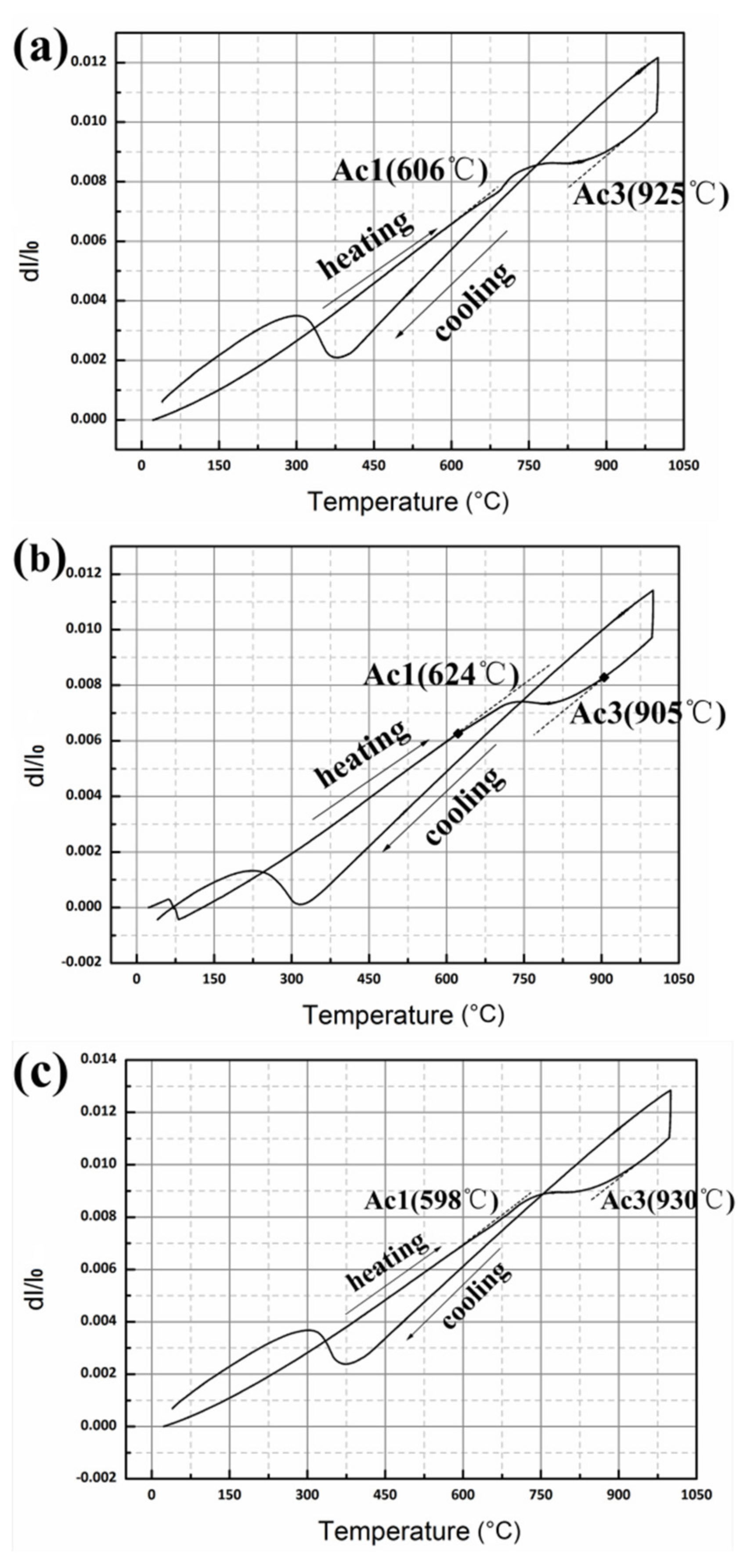
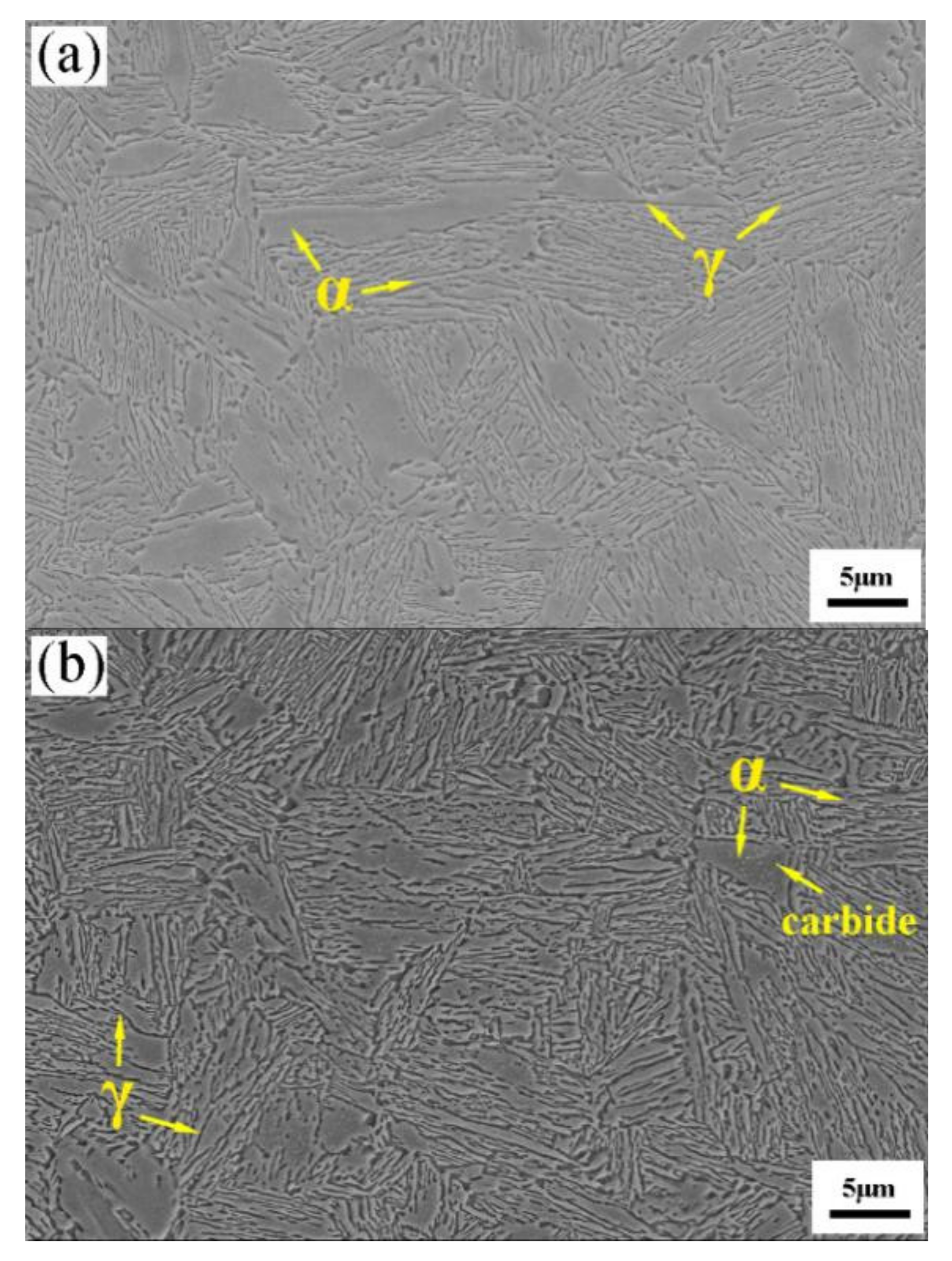
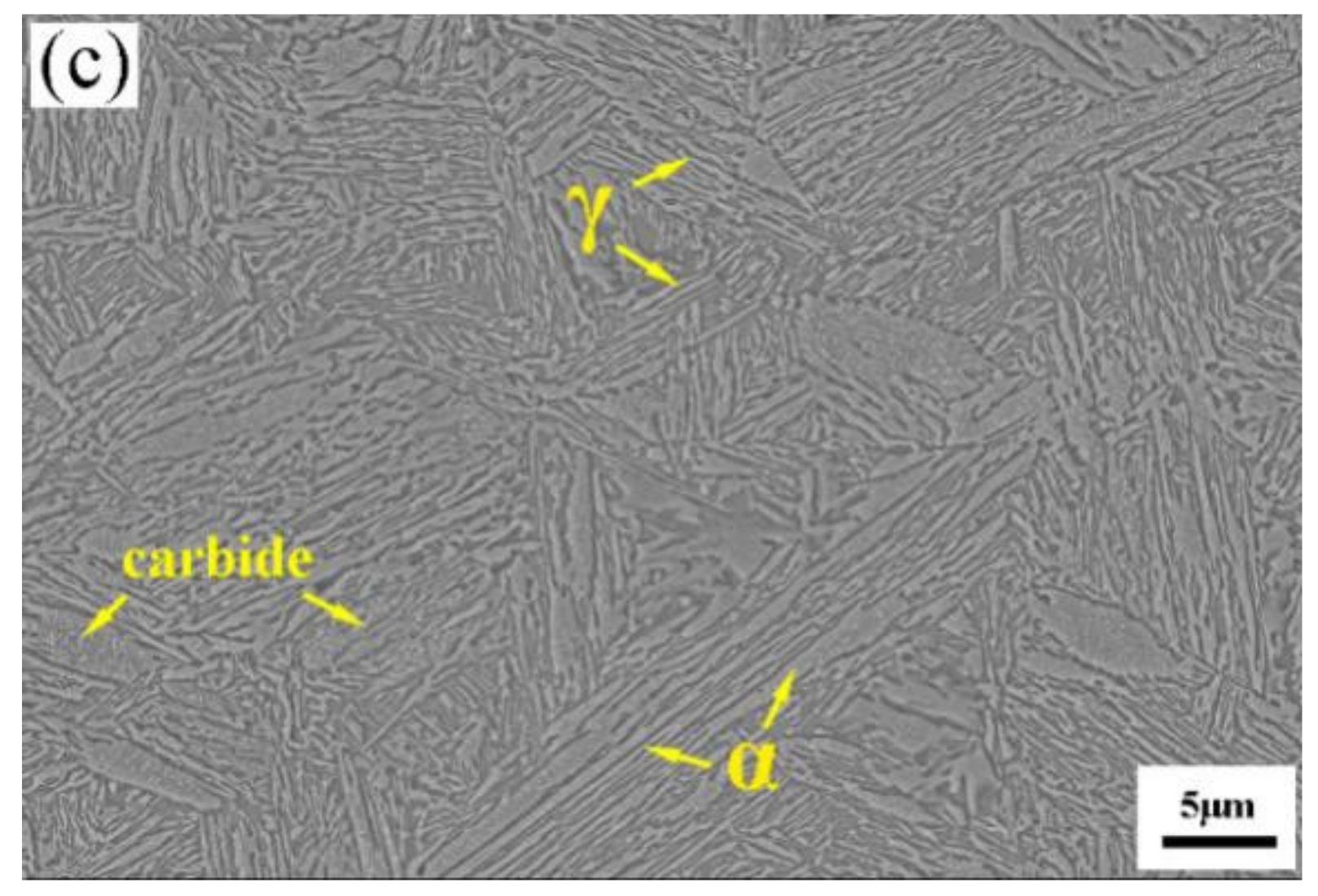
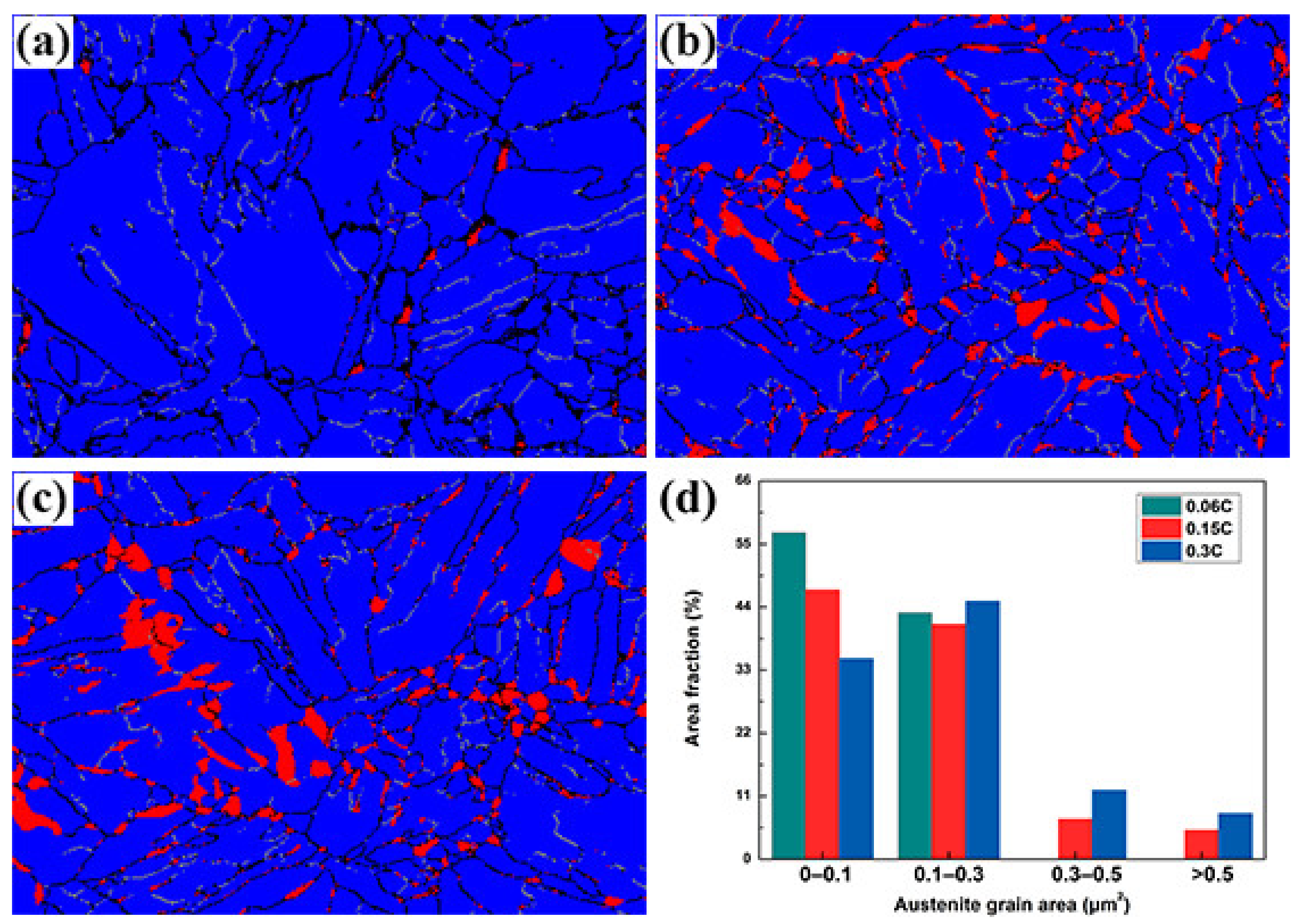
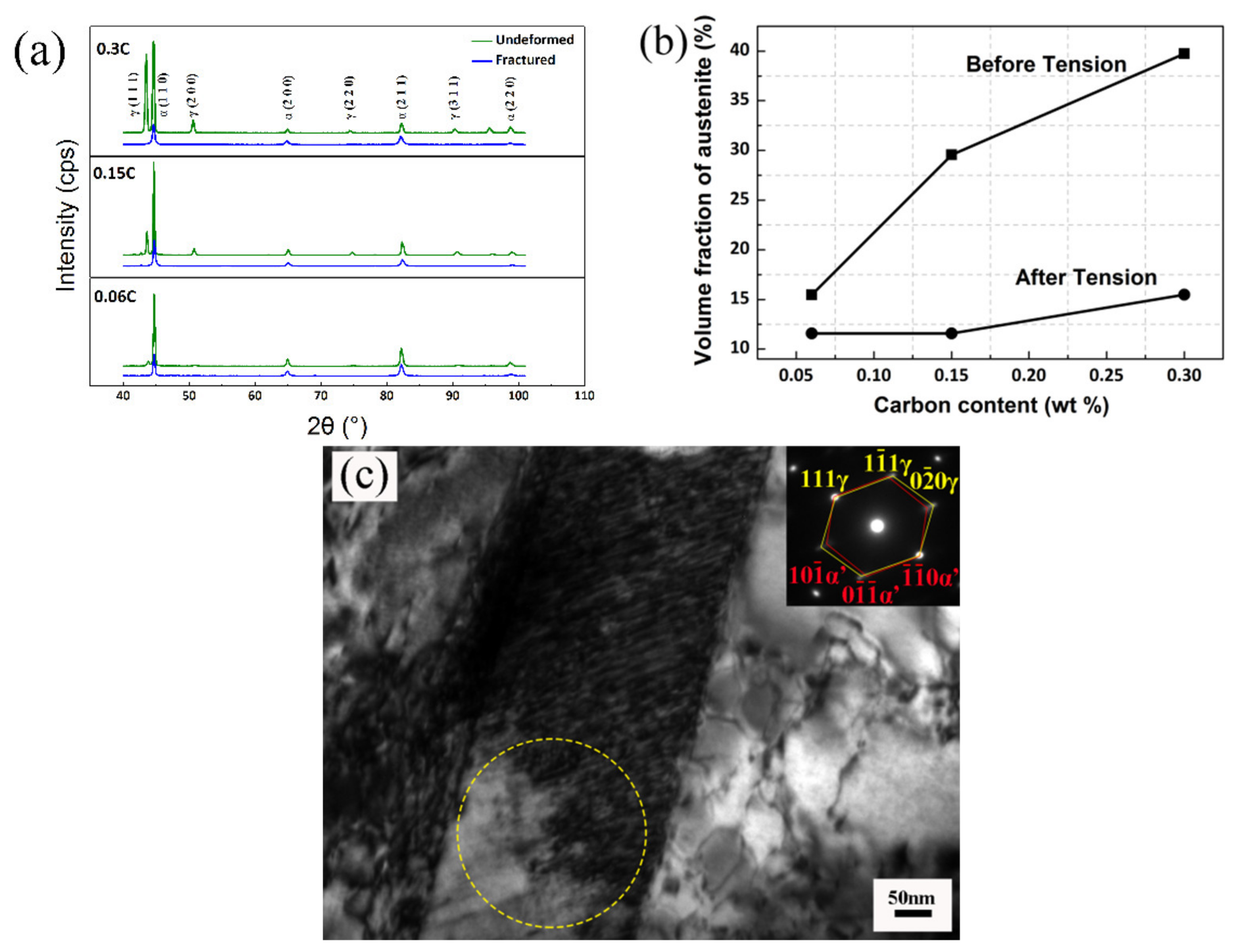
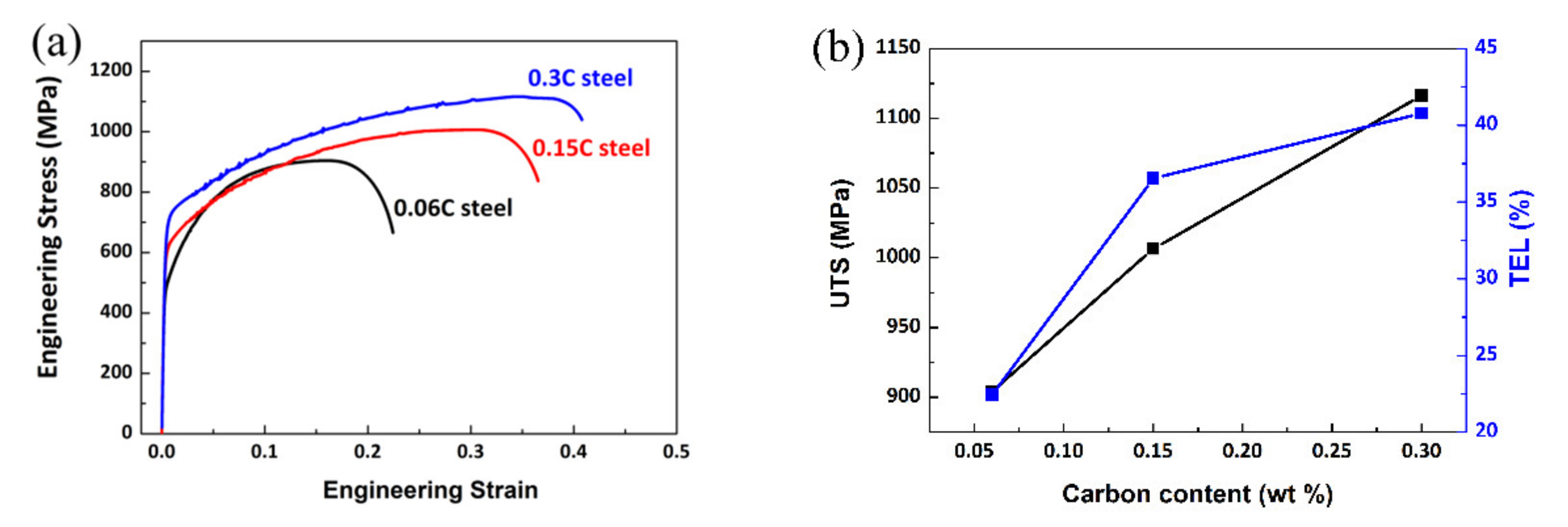



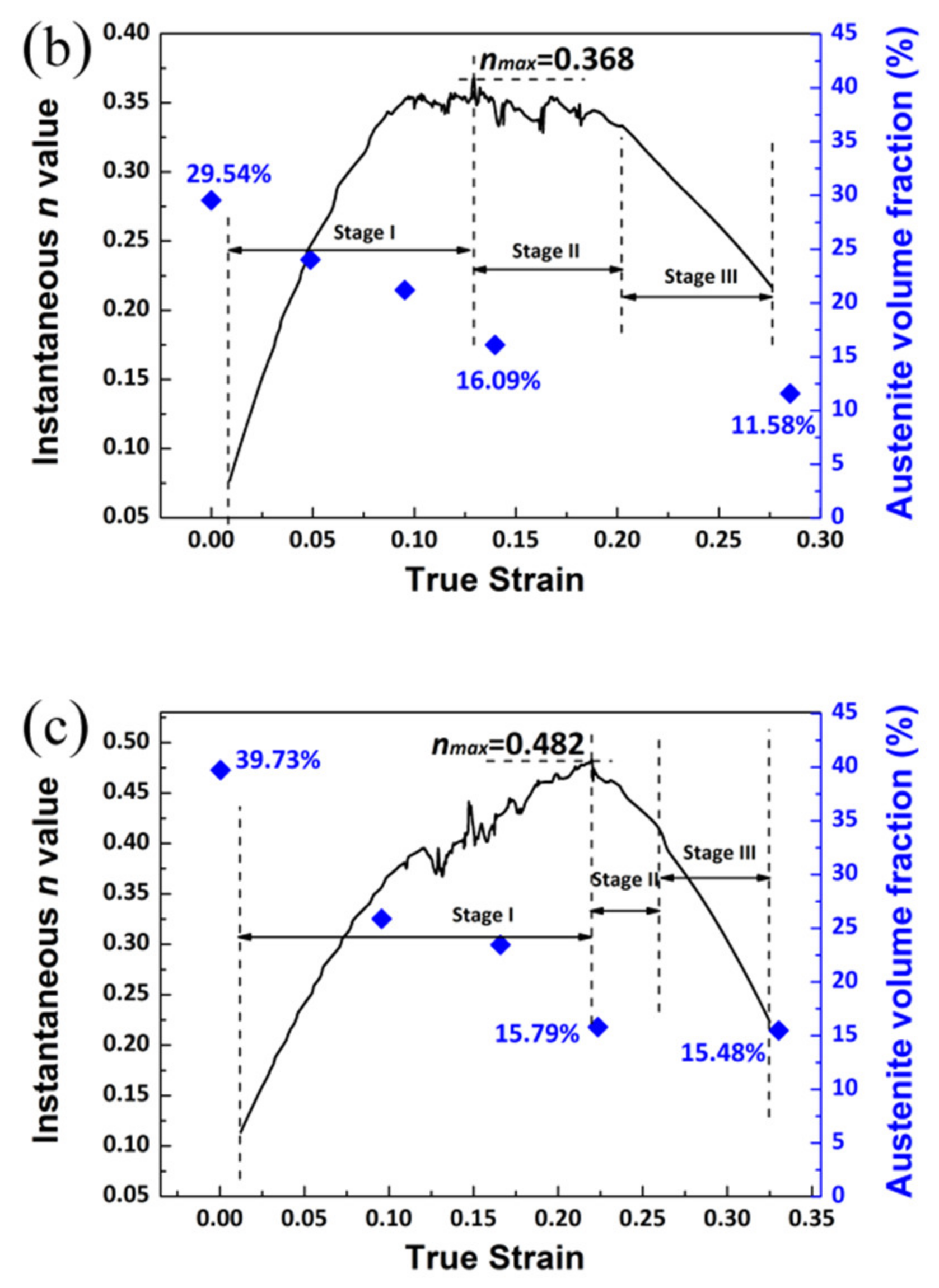

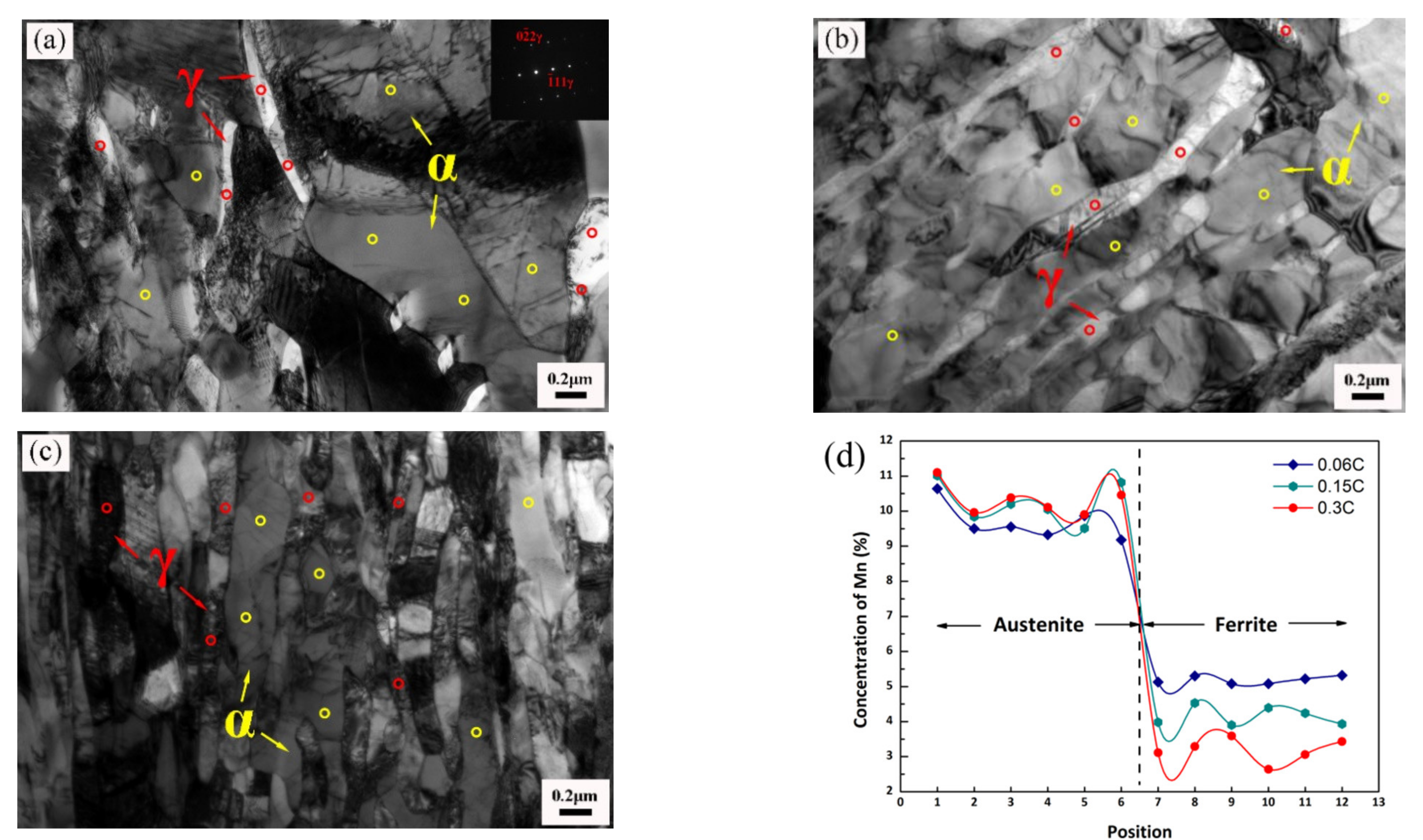
| C | Mn | Al | Fe | |
|---|---|---|---|---|
| 0.06C steel | 0.06 | 6.00 | 0.95 | Bal. |
| 0.15C steel | 0.15 | 5.92 | 0.90 | Bal. |
| 0.3C steel | 0.28 | 5.90 | 0.90 | Bal. |
| Before Deformation | After Deformation | |
|---|---|---|
| 0.06C steel | 1.04 | 1.83 |
| 0.15C steel | 1.13 | 2.40 |
| 0.3C steel | 1.40 | 3.22 |
| C Concentration | Mn Concentration | Mn > 7.1 (%) | Mn < 7.1 (%) | |
|---|---|---|---|---|
| 0.06C Steel | 3.3 | 4.9 | 12.7 | 87.3 |
| 0.15C Steel | 3.7 | 5.1 | 15.6 | 84.4 |
| 0.3C Steel | 4.9 | 6.0 | 25.3 | 74.7 |
Publisher’s Note: MDPI stays neutral with regard to jurisdictional claims in published maps and institutional affiliations. |
© 2021 by the authors. Licensee MDPI, Basel, Switzerland. This article is an open access article distributed under the terms and conditions of the Creative Commons Attribution (CC BY) license (https://creativecommons.org/licenses/by/4.0/).
Share and Cite
Zou, Y.; Ding, H.; Tang, Z. Effect of Carbon Content on Deformation Behavior and Partitioning of Manganese in Medium-Mn Steels. Metals 2021, 11, 667. https://doi.org/10.3390/met11040667
Zou Y, Ding H, Tang Z. Effect of Carbon Content on Deformation Behavior and Partitioning of Manganese in Medium-Mn Steels. Metals. 2021; 11(4):667. https://doi.org/10.3390/met11040667
Chicago/Turabian StyleZou, Yuming, Hua Ding, and Zhengyou Tang. 2021. "Effect of Carbon Content on Deformation Behavior and Partitioning of Manganese in Medium-Mn Steels" Metals 11, no. 4: 667. https://doi.org/10.3390/met11040667
APA StyleZou, Y., Ding, H., & Tang, Z. (2021). Effect of Carbon Content on Deformation Behavior and Partitioning of Manganese in Medium-Mn Steels. Metals, 11(4), 667. https://doi.org/10.3390/met11040667






